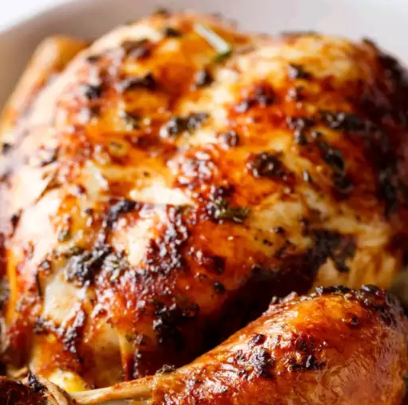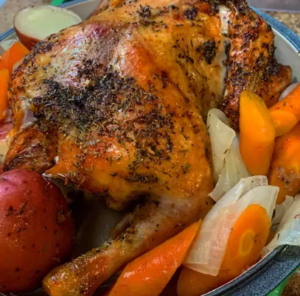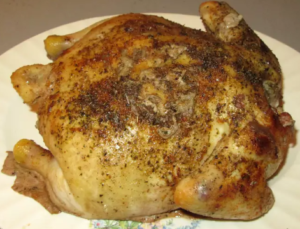Roasting Tips
Roasting chicken is an art, and like any good artist, knowing a few tricks of the trade can make a big difference. Start by preheating your oven—this ensures the chicken starts cooking immediately, sealing in juices. Place your chicken breast-side up in a roasting tray, ideally on a rack; this allows hot air to circulate around the chicken, cooking it evenly. Also, avoid overcrowding the pan, as this can cause steam, which might lead to a soggy skin rather than a crisply roasted one.
Temperature Control
One of the key elements in keeping your chicken moist is managing the oven temperature. High heat can cause the proteins to seize up and squeeze out moisture, making the meat dry. Roasting your chicken at a moderate temperature, around 350°F (175°C), helps preserve the moisture inside the meat while still achieving a golden-brown finish on the skin. If you’re aiming for extra crispy skin, consider blasting the chicken with high heat for the first 10-15 minutes and then lowering the temperature for the rest of the cooking time.
Using a Thermometer
The surefire way to avoid overcooked, dry chicken is to use a meat thermometer. Insert it into the thickest part of the thigh, making sure not to touch the bone, as this can give a false reading. The chicken is done when the thermometer reads 165°F (74°C). This precise method ensures that you’re cooking the chicken just enough to be safe and moist without crossing into overcooked territory.
By incorporating these effective cooking methods into your next roast chicken endeavor, you’re much more likely to achieve that perfect balance of juicy interior and crispy skin. Remember, the right temperature and tools are your best allies in the quest for the ultimate roast.
Advanced Tips
Spatchcocking the Chicken
Spatchcocking, or butterflying, ensures even cooking and faster cooking times. Removing the backbone and flattening the chicken exposes more surface area to heat. This uniform heating process keeps the chicken moist and speeds up cooking, reducing the risk of drying out.
Basting Techniques
Basting is a traditional method that involves spooning pan juices over the roasting chicken at regular intervals. This process helps to keep the meat moist by reintroducing surface moisture that has evaporated during cooking. For an extra boost of flavor and moisture, you can create a basting mixture with butter, herbs, and garlic. Just remember, every time you open the oven door to baste, you’re letting out heat, so keep the basting quick and efficient to maintain a consistent oven temperature.
Resting the Chicken
One of the most crucial steps often overlooked is resting the chicken after cooking. Resting allows the juices, which have been driven to the center of the bird during the heat of cooking, to redistribute throughout the meat. Cover your roasted chicken loosely with foil and let it sit for about 15-20 minutes before carving. This waiting period not only enhances the flavor but also ensures that the moisture remains locked inside, making each slice tender and juicy.
By mastering these advanced techniques—spatchcocking, basting, and resting—you’ll elevate your roast chicken game to new heights, ensuring it remains moist and flavorful every time.
Exploring Alternative Cooking Techniques
Using a Slow Cooker
While roasting is traditional, using a slow cooker can also yield incredibly moist and tender chicken. The slow cooker traps steam and moisture inside, effectively braising the chicken slowly and gently. This method is excellent for keeping all the juices within the meat, ensuring it stays succulent from start to finish.
Cooking Under a Brick
This lesser-known technique, often referred to as « pollo al mattone, » involves cooking the chicken under a preheated brick. This method not only flattens the chicken for even cooking but also presses the skin against the pan, ensuring it crisps up beautifully while the meat remains moist and tender. It’s a quick way to cook chicken compared to roasting, reducing the drying time significantly.
Sous-vide Method
For the ultimate in moisture control, sous-vide is a technique where the chicken is vacuum-sealed in a bag and cooked to a precise temperature in a water bath. This method allows the chicken to cook evenly and retain almost all of its juices, resulting in incredibly moist meat. Once cooked, a quick sear in a hot pan can add the desired crispiness to the skin.
By exploring these alternative cooking techniques, you can find new ways to ensure your chicken remains juicy and delicious, offering a variety of textures and flavors that might just become your new favorites.
Making the Most of Leftovers
Storing Cooked Chicken
Proper storage is key to maintaining the moisture and flavor of your roast chicken leftovers. Cool the chicken completely before refrigerating. Store it in an airtight container or wrap tightly in foil or plastic wrap to keep air out, which can dry the meat. Refrigerated properly, cooked chicken can last up to four days.
Creative Recipes for Leftover Chicken
Leftover roast chicken can be transformed into a variety of delicious dishes. Try making chicken salad, adding chunks of chicken to creamy mayonnaise, crisp celery, and a touch of mustard. Or, stir leftover chicken into soups and stews for added protein. For a quick meal, toss chicken pieces with your favorite vegetables and a sauce, then serve over rice or pasta.
By learning to store and repurpose your roast chicken leftovers effectively, you can extend the enjoyment of your meal and ensure nothing goes to waste.
Common Mistakes
Overcooking
One of the most straightforward mistakes that can dry out roast chicken is simply leaving it in the oven too long. Even with all the preparation in the world, overcooking will rob your chicken of its moisture, leaving it tough and unappealing. It’s crucial to cook the chicken just until it reaches the safe internal temperature of 165°F (74°C), as measured by a meat thermometer. Trusting your tools rather than guessing the doneness can save your dinner from disaster.
Frequent Oven Opening
Every time you open the oven door, you let out a significant amount of heat. This not only increases the overall cooking time but also disrupts the temperature balance, which is essential for cooking the chicken evenly and keeping it moist. Resist the urge to check on your chicken too frequently. Set a timer if you’re basting, and do your best to keep those oven door openings to a minimum.
By avoiding these common pitfalls—overcooking and excessive oven opening—you’ll be much better positioned to keep your roast chicken deliciously juicy. Remember, a little vigilance goes a long way in the kitchen!
FAQs
What is the best temperature to roast chicken at?
The ideal roasting temperature for chicken to achieve both a juicy interior and a crispy exterior is typically around 350°F (175°C). This moderate heat helps cook the chicken evenly without drying it out. If you prefer a crisper skin, you can start at a higher temperature (around 425°F or 220°C) for the first 15 minutes and then reduce it to 350°F (175°C) for the remainder of the cooking time.
How long should I brine the chicken?
Brining time can vary depending on the size of your chicken, but a general rule is to brine for at least 1 hour per pound. However, do not brine for more than 24 hours as it can start to break down the meat’s texture, making it mushy. Overnight brining is often ideal for achieving optimal moisture and flavor infusion.
Can I roast a chicken without basting?
Yes, you can roast a chicken without basting. While basting helps add surface moisture during the cooking process, using other methods like brining or marinating beforehand can maintain moisture internally. Additionally, ensuring you do not overcook the chicken and allowing it to rest properly after cooking will help retain its natural juices.
By addressing these common queries, we hope to enhance your confidence and skills in roasting the perfect chicken, ensuring it’s always juicy and delicious.
Recommended Internal Links
- Article on Juicy Roasted Chicken:
- Phrase for linking: « enhance the flavor of your chicken »
- Internal link: Teriyaki Salmon Recipe to suggest a different protein preparation with a unique flavor profile.
- Article on Southwestern Egg Rolls:
- Phrase for linking: « try a different appetizer »
- Internal link: Best Bread Machine Bread to offer an alternative easy-to-make snack or appetizer.
- Article on Quick and Easy Brownies:
- Phrase for linking: « explore other quick desserts »
- Internal link: Chocolate Fondue for a simple yet delightful dessert option.
- Article on Strawberry Rhubarb Pie:
- Phrase for linking: « complementary fruity dessert »
- Internal link: The Best Strawberry Cake to connect readers interested in another fruit-based dessert.
- Article on Pasta Salad:
- Phrase for linking: « other pasta dishes to enjoy »
- Internal link: Tomato Cream Sauce for Pasta to guide readers to more pasta recipe options.
Additional Resources and Readings
- The New Yorker Article on Perfecting Roast Chicken
- Phrase for linking: « French techniques for perfect roast chicken »
- External link: Perfecting Roast Chicken, the French Way
- This article discusses various traditional French methods that enhance the moisture and flavor of roast chicken, which can be a great addition to your section on advanced cooking techniques.
- Bon Appetit’s Comprehensive Guide to Roasting Chicken
- Phrase for linking: « comprehensive guide on roasting »
- External link: How to Roast a Chicken: The Ultimate Recipe, Tips, and More
- Ideal for readers looking to dive deeper into the topic, this guide from Bon Appetit offers detailed instructions and tips on roasting chicken, making it a useful resource to link from your cooking methods section.
- Kitchn’s Tutorial on Perfect Roast Chicken
- Phrase for linking: « learn more about the art of roasting chicken »
- External link: How To Roast a Perfect Chicken – Kitchn
- Suitable for readers who are new to cooking or looking to perfect their technique, this article provides step-by-step advice and could be linked from your introduction or preparation sections to give readers additional practical advice.
Conclusion and Recap
How do you keep roast chicken from drying out?As we conclude our guide on keeping roast chicken moist, here’s a quick recap of essential techniques. Start by choosing a preparation method: brining, marinating, or seasoning. Each is key for moisture retention. Master cooking with precise temperature control and keep oven openings minimal. Don’t skip final steps like spatchcocking for even cooking, basting for flavor, and resting the chicken to redistribute juices.
Adopt these methods and pay attention to details. Every step, from preparation to carving, enhances moisture and flavor. With practice, you’ll serve roast chicken that’s not only stunning but also tender and juicy.




1 réflexion au sujet de « How do you keep roast chicken from drying out »